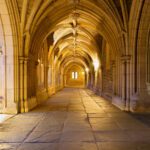For a long time, people have been fighting against one another to build larger and taller skyscrapers. The task becomes considerably more complex and costly with today’s superior construction technologies. That’s why the Burj Khalifa is so well-known: it now holds one of the world’s most prestigious titles.
While compiling a list of the world’s tallest buildings may appear simple, several players differ on the game’s rules. Is it possible to just put a spire on a structure and count it as height, or is it cheating? Is it necessary to take the final measurement from the roof’s height? Do floors that aren’t occupied count toward height, or is that cheating?
The CTBUH, or Council for Tall Structures and Urban Habitat, is a group that helps to determine how we measure buildings. We identified the 10 unambiguous winners for the world’s tallest buildings—not simply any non-occupiable structure—using their database.
10 Cities With the Most Skyscrapers

1. Burj Khalifa
The Burj Khalifa, also known as the Khalifa Tower, is the world’s highest structure. It stands at a height of 2,717 feet and has a total of 160 floors. It was named after Khalifa bin Zayed Al Nahyan, the president of the United Arab Emirates and ruler of Abu Dhabi, in recognition of the funds he gave to help finish the structure.
The bundled tube structural system is used on the Burj Khalifa, and it works by connecting several structural tubes that resist lateral stresses and operate as a giant hollow cylinder.
Tube structural solutions, such as bundled tubes, are very efficient and may be utilized to achieve remarkable heights. It was influenced by Islamic architecture and designed by Skidmore, Owings, and Merrill, or SOM.
2. Shanghai Tower
Although professional golfer Walter Hagen may believe that “no one remembers who came in second,” China’s Shanghai Tower is tough to forget. The skyscraper also has the world’s fastest elevators and the world’s highest indoor observation station, which it shares with the Ping An Finance Center.
Regardless of these second-place finishes or near-wins, you won’t be disappointed if you visit Shanghai Tower. Each floor plate is meticulously turned to produce a smooth twist that spans the whole height of the structure.
Aside from architectural design selections, the function of the curtain wall system is also intriguing. The wind turbines, solar-protective curtain wall system, and geothermal energy sources are some of the green aspects that support this assertion.
3. Abraj Al-Bait Clock Tower
Perhaps the most unusual skyscraper on our list is the Abraj Al-Bait Clock Tower. It doesn’t appear that the pencil towers you might have envisaged would assist you in gaining the extra height. It is really a series of seven structures that serve to the numerous pilgrims that visit Mecca. It is translated from Arabic as “Towers of the House.”
It’s also in an ideal location because many pilgrimages culminate right next door at Islam’s holiest site, the Great Mosque of Mecca.
The Makkah Royal Clock Tower is the building that gives the Abraj Al-Bait Clock a spot on this list. It is home to the Clock Tower Museum, which spans four floors and has the world’s biggest clock face. Though this huge tower is stunning in and of itself, it is difficult to distinguish it from the rest of the enormous complex.
4. Ping An Finance Center
The Ping An International Finance Center is the world’s fourth-tallest structure, It is clearly a technical wonder. The structure was on the verge of surpassing the Shanghai Tower and becoming the world’s tallest building, but the antenna was never built due to concerns that it might disrupt flight pathways.
It does, however, offer the world’s tallest inside observation deck (tied with the Shanghai Tower), which is a popular destination for travelers who aren’t frightened of heights.
The Ping An International Finance Center also serves as the center of the Futian Sector, the city’s primary commercial district, which serves an essential municipal purpose.
5. Lotte World Tower
The Lotte World Tower is a diagrid structure known as “Korea’s crown gem.” Lotte World Tower got its name from its developer and owner, Lotte Group, who also owns the surrounding recreation area. Both are popular tourist locations in Seoul.
The lighter color palette of the glass curtain walls, as well as the building’s smooth curve, are inspired by Korean ceramics and are a strong contrast to the hilly city.
The structure has all of the mixed-use spaces we’ve come to anticipate from super-tall skyscrapers, such as offices, commercial space, and a posh hotel, but it also incorporates a new sort of functional space unique to Korea: “officetels.” An officetel, is a combination of the world’s office and hotel, a sort of mixed-use facility akin to a studio apartment that mixes living and working space.
6. One World Trade Center
1 WTC, mostly known as the Freedom Tower, is the highest structure in the Western Hemisphere and the sixth tallest building in the world. It was originally known as the northern tower of the Twin Towers, which was destroyed in terrorist attacks on September 11, 2001.
This tower is part of a much bigger complex that includes many business buildings and the National September 11 Memorial & Museum, located on the original Twin Towers’ site in New York.
The official height of the structure is 1,776 feet in reference to the year the Declaration of Independence was signed, commemorating the formation of the United States of America.
7. Guangzhou CTF Finance Center
The Guangzhou Chow Tai Fook Finance Center assists Guangzhou’s megacity in meeting its recent growth and urban expansion. The structure is supported by eight giant columns and rests on a platform or podium of eight levels of large public spaces, comparable to the Tianjin CTF Finance Center.
The Guangzhou CTF Finance Center is an excellent example of a skyscraper where “form follows function.”
Because the multifunctional structure serves many tasks, it needs somewhat varying floor sizes. As a result, the structure simply functions as a wrapper around these regions, allowing the requirements of each space to dictate the design.
8. Tianjin CTF Finance Center
The Tianjin Chow Tai Fook Binhai Center is the highest skyscraper in the world with fewer than 100 floors. The tower is part of the Tianjin Economic Development Area, which is a free market zone in Binhai, Tianjin, China, and includes new apartments, office spaces, and a hotel.
The building’s exquisite curve is generated by eight flawlessly integrated giant columns that sustain the structure while also creating aesthetically pleasant weaving shapes in the design.
The design also helps the building deal with wind forces since it is aerodynamic like a vehicle and has no sharp edges, allowing the wind to easily wrap around it. While it is now the highest building in Tianjin, the Goldin Finance 117, which is currently under construction, will shortly eclipse it.
9. China Zun
The CITC Tower, also known as China Zun, is Beijing’s tallest structure and may remain thus for a long time because of new height limitations for future constructions.
The name and design inspiration for China Zun comes from a historical vessel that the architects abstracted to match its record-breaking construction. (A zun is an antique wine vessel used in Chinese rites from the Bronze Age.)
This shape also had an additional purpose: the vessel’s natural curve, which is broader at the top and bottom and thinner through the middle, provides good protection against seismic activity.
10. TAIPEI 101
Taipei 101, formerly known as the Taipei Financial Center, is one of the most recognizable skyscrapers on this list. It was also the highest skyscraper in the world for a time before being surpassed by our current champion, the Burj Khalifa.
While many skyscrapers are instances of modern architecture that may be seen elsewhere, Taipei 101 has a particular Asian flavor.
The structure is divided into eight vertical sections, each with eight stories. This is tied to the Chinese idea that the number eight represents prosperity, riches, abundance, and good fortune. Each cluster also has an abstracted bamboo stalk, a pagoda, and Chinese ingots or money boxes.
The whole structure also meticulously addresses feng shui theory in several design components at various scales.
You might also like: 10 Most Stunning Cathedrals Around the World














